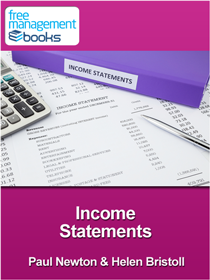Income Statements - Free eBook in PDF Format
 |
 |
|
Book Description - ISBN 978-1-62620-955-8 (38 Pages)
This free eBook you will give you a thorough understanding of the income statement, a powerful decision-making tool that every manager should be familiar with.
Chapter 1 - Income Statement Definition
The primary purpose of the income statement is to report an organization's earnings to investors over a specific period of time. It can also be used to judge how well the organization is managed financially; decide the type of investment opportunity it presents; make comparisons with its competitors; and assess its operating performance.
Chapter 2 - Income Statement Format
There are a variety of different types of income statements that organizations use, but the most common are the single-step format and the multi-step format
Chapter 3 - Multiple-Step Income Statement
The multiple-step income statement explicitly segregates the operating revenues and operating expenses from the non-operating revenues, non-operating expenses, gains, and losses. This makes it easy to see the gross profit, operating profit, and the net profit.
Chapter 4 - Income Statement Explained
Do not be surprised if a monthly income statement does not show the effects of individual transactions that you might expect to see. Income statements ONLY show irrevocable transactions; they do not show requests or promises.
Chapter 5 - Operating Expenses Definition
There are accounting standards to help you define operating and non-operating expenses. These cover research and development costs, sales and marketing costs, general and administrative costs, and EBITDA (Earnings Before Interest, Taxes, Depreciation, and Amortization).
Chapter 6 - Income Statement Ratios
The best way to use an income statement is to compare a recent one with earlier ones for a similar period. Income statements used for comparison can use dollar amounts, percentages, or a combination. Using income statements to make comparisons is an extremely useful management decision-making tool.
Chapter 7 - Common-Size Income Statements
Common-size income statements using percentages can only be used to compare organizations of differing sizes. These can provide valuable input into the management decision-making process. Common-size income statements can also be used to compare your organization's figures to the average for your industry.
Chapter 8 - Common-Size Analysis
When performing a common-size analysis the profitability indicators you should look at are gross profit margin, operating profit margin, and net profit margin.
Chapter 9 - Income Statement Cash Flow
Comparing an income statement with the relevant cash flow statement shows how much of the profit is supported by cash actually coming into the company. Understanding how aggressive an organization is in their revenue recognition helps you determine the quality of the data that is shown on the income statement.
| You will learn: |
|
![]()
![]()
Great For Beginners and Business Students
I had to write a report on income statements for one of my classes. While I had a book that should have thoroughly explained it, I found myself at a loss on what an income statement even was. I knew I was in trouble. The book that I had did not make any sense to me. I had to look up the definition of one term just to try to understand what the sentence was talking about. It was taking me a long time just to finish one page, since I had to keep stopping and flipping through the pages to look up the definition. I decided to search the internet for something that was intended for beginners.
I needed a book that used the terms, but also defined them right in the reading as well. I also wanted a book that I could understand in a short amount of time because I did not want to spend my weekend learning what an income statement was and then even more time writing a report about it. I found this book. When I realized that this book was short AND free, I immediately downloaded it.
I knew this was exactly what I was looking for when in the beginning of the book it started talking about operating items section and non-operating item section. Not only did it define what both operating items section and non-operation items section was, but it also gave easy to understand examples. It was all together on the same page too! There is an image used that breaks down exactly what an income statement is used for. The two types of income statements used are the single step format and the multiple step format.
I figured that I would be able to follow the single step format, but I was worried that I would be lost during the multiple step format. The single step format is net income equals revenue plus gains subtracted by expenses plus losses. Again they used a simple graphic to easily demonstrate this. After that description they follow it up with an example of an income statement that uses the single step format. I like that the book defined what revenue is and also briefly reminds you what accrual accounting is too. Gains and revenue have always been a little confusing to me so I was glad when each term was broken down for me to understand. Since gains are part of the single step format it was important for me to understand how gains are calculated. Expenses seemed to me like it was pretty straight forward, but I was unaware of using expenses in primary activities and expenses in secondary activities. Expenses of primary activities according to the book are "the costs that are incurred in order to earn normal operating revenues." This seemed a little confusing to me, but the author uses an example throughout this section to help better understand this section.
Expenses in secondary activities, like interest, are not caused to earn normal operating revenue. Using the same business as an example, the book moves on to cover multiple step income statements. Prior to reading this I figured that you could use an income statement to make a budget. I learned from this book that you should not use an income statement as a budget, but they can be a useful tool to be used with other accounting tools. Overall, I was surprised at which the depth this book went into, given that the book is only 37 pages long. The author did a great job of starting at the beginning and using and defining terms that I could understand.
The book also uses the same business throughout the book as an example that helps you understand the difference between single step and multiple step income statements. I really liked that the book explains the main points several times. If you are a beginner, you should be able to read this book and have a good understanding of income statements by the time you finish. You should also be familiar with several terms that are used thought the finance world. This is a book that should be used in the classroom as well as for anyone who needs to learn about income statements.
Betty Harmon

